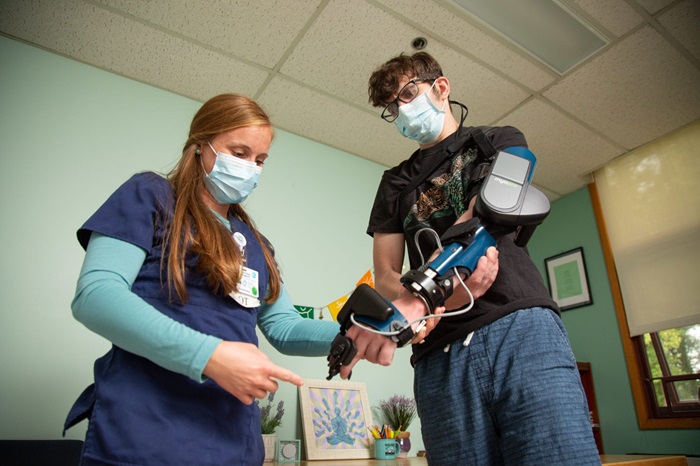25-year-old Man on the Road to Recovery After a Debilitative Brain Injury

August 25, 2021
At age 25, Michael Segarra landed in the hospital with a blood infection, expecting a short stay. But his heightened blood pressure caused a rupture in an arteriovenous malformation (AVM)—basically, a ticking time bomb in his brain. He was quickly transferred to Jersey Shore University Medical Center, where emergency surgery saved his life.
But the aftermath of his brain injury was severe: Michael could not talk, walk, eat or even breathe on his own. His parents, Luis and Barbara, feared for their son’s future.
After surgery, he was transferred to the Brain Trauma Unit at JFK Johnson Rehabilitation Institute. Under the care of Richard J. Malone, D.O., a brain injury specialist, and with the help of therapists trained in brain injury rehabilitation, Michael took slow, incremental steps. He slowly began to move an arm, then a leg. Soon he could eat.
Tackling a New Obstacle
More than three years after his 2017 brain injury, Michael is home with his parents and preparing to take college classes. He is learning to drive again, this time with a modified car.
His greatest obstacle now is something he did not understand before: spasticity.
“To me, it was a word you might use as a kid to make fun of somebody. I hope I never did that because I really understand now,” Michael says.
His right arm curls in and his right foot points awkwardly. But he moves forcefully with a brace. Since his brain injury, Segarra has been working with Steven V. Escaldi, D.O., medical director of the JFK Johnson Spasticity Management Program.
Botulinum toxin injections enable Michael to gain more control of his curled and affected left arm, which he calls his “T-rex arm.” “Before the injections, if I wanted to grab a snack off the top cupboard, I just couldn’t reach. The injections loosen everything up, and I have more use of my hand,” Michael says. “Dr. Escaldi knows how to find the muscles that are firing and put the Botox in the right place. You don’t want too much tone and rigidity, or my arm would be too loose. Dr. Escaldi is the best doctor.”
Michael’s occupational therapist is now working with him as he uses a powered arm and hand brace. The device amplifies weak muscle signals and acts like “power steering for your arm.” The aim of the robotic technology is to drive muscle reeducation and increase range of motion.
Michael has come very far since his ruptured AVM. Dr. Escaldi says his improvement shows the value of his dedication to the program and the support of his family.
The material provided through HealthU is intended to be used as general information only and should not replace the advice of your physician. Always consult your physician for individual care.
Find a doctor near me
4 Common Injuries from Combat Sports

Craig Van Dien, M.D., says that he frequently sees hand and wrist injuries related to combat sports.
Do You Feel Like Your Bladder Is Dropping?

Pelvic organ prolapse treatment options available. Dr. Bhatia offers solutions for pelvic pressure, incontinence, and other symptoms. Learn more & schedule an appointment.
Find a doctor near me

Five Tips for a Healthier Workout
Three of our cardiologists share how to fit heart healthy exercise into even the busiest schedules.

8 Possible Causes (and Treatments) for Your Dizziness
Research shows that dizziness, vertigo and balance problems affect about 15 percent of U.S. adults each year.

PCOS vs. Endometriosis: What’s the Difference?
Understand PCOS vs. endometriosis differences. Learn key symptoms & treatments from Dr. Appelbaum. Get expert care. Call 800-822-8905.

How to Check Your Heart Rate
Learn how to check your heart rate. Dr. Batsides offers guidance on understanding your pulse, improving your health, and scheduling an appointment. Call 800-822-8905.
